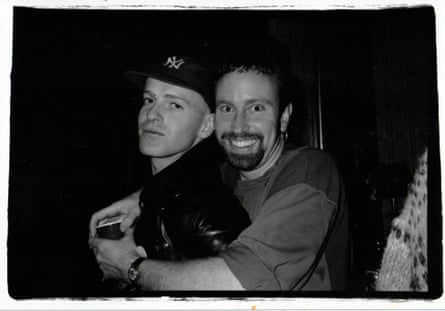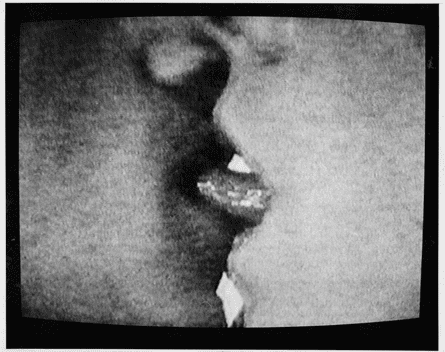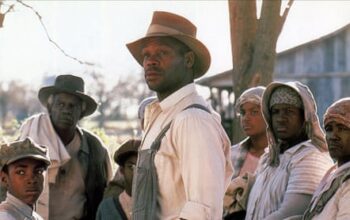On 25 January 1992 a group of gay and queer film-makers took to a stage at Sundance film festival to discuss a watershed moment for LGBTQ representation on screen. On the panel were a young Todd Haynes and the veteran British director Derek Jarman, as well as the 18-year-old prodigy Sadie Benning (who would go on to co-found the riot grrrl act Le Tigre). Among this august company were two Sydney film-makers: Stephen Cummins, then 31, and a 29-year-old Simon Hunt, who would later become a satirical sensation through his alter ego Pauline Pantsdown.
The Australian duo were at Sundance to show their homoerotic experimental short film Resonance and the mood was electric: the previous year, Haynes’ debut feature Poison and Jennie Livingston’s now-canonical documentary Paris Is Burning had won big prizes at Sundance – and “a million queer people”, had turned out, Hunt recalls. It was also the peak of the Aids crisis. “Art itself was seen as [a form of] activism,” he says. “‘We don’t know how long we’re going to live, so we have to find happiness, we have to make a mark, we have to be seen.’ It drove everything, really.”

The panel was later identified as the tipping point for the “new queer cinema” movement that birthed mainstream films including Kimberly Peirce’s Boys Don’t Cry and Anthony Minghella’s The Talented Mr Ripley.
Cummins would not live to see this. In 1994 he died from Aids-related illness aged 34. His legacy endures in Sydney’s cultural institutions, including the film festival organiser Queer Screen, which Cummins co-founded in 1993, and the Stephen Cummins residency for queer artists at Performance Space, an experimental arts incubator.

This month a package containing nine of his short films will screen at Melbourne international film festival, following its Sydney world premiere in 2023 and a screening at London’s Barbican Centre in March. The program showcases poetic and erotic student films shot on Super 8 (made when Cummins was at Sydney College of the Arts) and cheeky, utopian visions of homosexual joy and intimacy in public.
Among the picks is the work Cummins screened at Sundance: Resonance, a lush, 35mm black and white film that won best short at Sydney film festival in 1991 and showed at more than 100 international festivals. The program also includes two key later works: a 30-second closeup of two men kissing, which was commissioned to screen on Perth television during commercial breaks but was banned by the TV station; and the anarchic video and animation mashup The HIV Game Show, which was completed posthumously by Hunt and based on a fragment of a documentary treatment Cummins was working on when he died.


Poignantly, the films span a key decade in Australia’s queer history: from 1984, when homosexual sex was decriminalised in New South Wales and HIV/Aids was spreading rapidly through the country, to 1995, when treatments were becoming available. Hunt, who became close friends with Cummins in the mid-80s and collaborated with him over the decade (as composer, sound designer and writer) recalls: “We had so many people dying, and then suddenly, people who made it to the end of 1994 had all these pills, and most of them are still around.”

Cummins’ films are inextricably tied to this context, says Hunt: “We’d been having illegal sex for the first four or five years of our adult lives – and that really sort of holds you back and pushes you [as an artist] towards metaphor. Then suddenly you weren’t facing 12 years jail for having sex with your boyfriend any more – but here’s this disease that’s going to kill you. And I think that accounts for the joy [in Cummins’s films]: the sense that despite all of this, whatever you throw at us, we are going to make our place [in society] and we’re going to find joy in life.”
Nowhere is this resilience more evident than in Resonance, which was inspired by an attack on Cummins in a Sydney laneway by a group of men screaming homophobic slurs. The film opens with a similar act of violence against a young man, before showing him heal and rebuild himself through queer love and intimacy. Resonance uses dance and movement rather than dialogue, a reflection of Cummins’ strong ties to Sydney’s dance and performance art scenes. In a lyrical sequence set in a boxing ring, contrasting versions of masculinity are shown as two men move from fighting each other to dancing in synchronicity.
The artist and academic EO Gill, who discovered Resonance in 2013 when they were selected for the Stephen Cummins residency, says it continues to have a profound effect. “It totally changed me; it changed the way I thought about film, about what film can do,” they said. “It made me think I can make work like this.” Gill rewatches it every few years and shows it to students and emerging queer artists. “Every time I show it, they’re like, ‘Wow.’”
For Gill, Cummins’ films also have broader resonance. “His work is experimental but it’s incredibly accessible, too – it makes you feel something, regardless what your reading of it might be.”
-
Stephen Cummins’ films screen on 23 August at Melbourne international film festival
Source: theguardian.com


